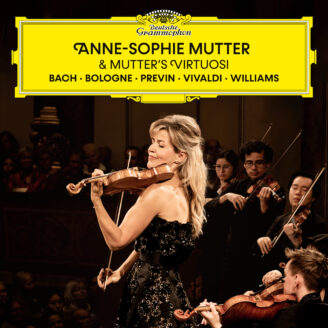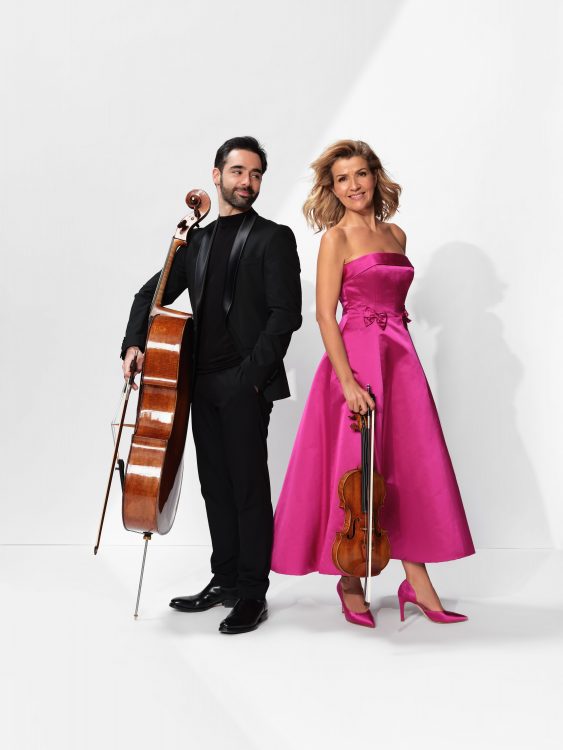Anne-Sophie Mutter takes up the story: “We did another performance of the Brahms Double, this time in Oxford, and I felt that artistically we had a very personal musical conversation, which was always inspired and inspiring: fresh, open-minded, new and very much in line with the composer’s style.” This is how Pablo Ferrández has come to partner Anne-Sophie Mutter in her second recording of the Brahms Double Concerto (the first, with cellist Antonio Meneses and the Berlin Philharmonic conducted by Herbert von Karajan, was made back in 1983).
Anne-Sophie Mutter has worked with most of the world’s greatest cellists over the past several decades: “First of all, Mstislav Rostropovich, from whom I learned a lot,” she says. “I hope that the young generation, with Pablo in the forefront, will follow in Rostropovich’s footsteps in enlarging the instrument’s repertoire, because the cello for a long time was really in the shadow of composers’ attention. It was Rostropovich who changed that, followed of course by Yo-Yo Ma and Lynn Harrell.” Rostropovich and Karajan were among her early mentors. “Now Pablo and I are doing the Brahms together, I’m very happy to be in the role of a musician and a mentor to my young colleague,” she says, “and I’m a fan of Pablo’s.”
Recordings do not often pair a concerto with a chamber work, but here powerful personal reasons make the two composers an ideal mix. Anne-Sophie Mutter is in no doubt: “Clara Schumann belongs to Johannes Brahms. Johannes Brahms belongs to Clara Schumann.”
Clara Schumann was not only a legendary pianist, but also a formidable composer; yet in that capacity she was long overlooked by music history. “She started her performing career aged 12, touring Europe, and she concertized for 60 years,” Anne-Sophie Mutter says. “She began the tradition of playing without the score. And she was the wife of Robert Schumann. It was extremely difficult for her to develop as a composer because she was in the shadow of this genius, and besides, while she was trying to maintain her musical career, she was also giving birth to seven children.”
In February 1854, Robert Schumann suffered a complete breakdown – possibly due to mental illness, tertiary syphilis or both. After attempting to take his own life, he was confined to an asylum at Endenich, near Bonn, where he later died. Clara Schumann was left grieving for him and trying to support her children on her own.
About four months before Robert Schumann’s devastating crisis, the family had had an unexpected visitor: a young composer from Hamburg, introduced to them by the violinist Joseph Joachim. “Brahms met Robert and Clara Schumann when he was only 20,” Anne-Sophie Mutter recounts. “About three months afterwards, he wrote his first piano trio [op. 8], which he revised some 35 years later. His connection to the Schumanns was extremely strong, particularly to Clara. You could call it a romantic relationship in that we are certain that they adored each other artistically, and that Johannes very often asked her advice.”
During Robert’s long illness and after his death, the young Brahms became a vital support for Clara, both practically and emotionally. His letters to her reveal a veritable infatuation on his side, though there is no proof that their relationship went any further. “There were rumours that when she was a widow, Brahms was waiting for her to make a move,” Anne-Sophie Mutter says. “Her last child, Felix, was born when Robert Schumann already was in the asylum, and Brahms became the godfather – he treated Felix like his own son. So there is enough personal and artistic evidence that if you think of Clara Schumann, you have to think of Johannes Brahms; and if you think of Johannes Brahms, you have to think of Clara Schumann.” Ultimately it was a friendship that remained deep and close, barring a few ups and downs, for the rest of their lives.
Pablo Ferrández has a special reason of his own for loving Clara Schumann’s music: “I used to live in Clara Schumann’s house!” he says. “When I was a student, my sponsors owned the house in Frankfurt where she had lived for around the last 18 years of her life. Then they invited me to come and live with them, so I have always felt connected to her.”
There is one more factor behind the decision to record her Piano Trio: the recent (and long overdue) focus among audiences and the music industry on the works of female composers. “We live in times where we have to realise that our repertoire needs to become much more diverse,” Anne-Sophie Mutter says. “So that’s another strong reason why we want to put Clara Schumann’s trio in the forefront. It seemed totally organic to couple it with Johannes Brahms, because their human and artistic relationship is simply inspirational.”
Anne-Sophie Mutter, Pablo Ferrández and Manfred Honeck at Dvořák Hall, Rudolfinum, in Prague Joachim, Brahms and Clara Schumann became a personal artistic triumvirate, sharing ideas and advice – not least, on what to do about Robert Schumann’s legacy of unpublished or revised pieces of music. Joachim, however, was a notoriously complex character and although he and Brahms had been close friends since their youth, they fell out badly in 1883, when Joachim’s marriage to the singer Amalie Schneeweiss broke up and Brahms took Amalie’s side. The Double Concerto of 1887, Anne-Sophie Mutter says, represented the composer and the violinist’s long-awaited reconciliation.
“They didn’t speak for about four years. Then Brahms was vacationing by Lake Thun in Switzerland, where he had written some of his happiest music, including the A major Violin Sonata. Now he sent Joachim a letter, saying that he was writing the Double Concerto. It was his last orchestral piece and you can sense the mood of reconciliation within it, whether in its heroic heights or in the tenderness of a pianissmo marked dolce. It certainly brought them together again, so it has a deep significance not only in the repertoire, but also in the life of these two great musicians.”
Clara Schumann’s piano trio is a landmark in a very different way. It is one of her finest works and dates from 1846, when the Schumann family, having moved to Dresden, were facing difficult times with a conglomeration of personal troubles. Her musical voice is highly individual and, interestingly, has little in common with either Brahms or Robert Schumann: “It reminds me more of Mendelssohn,” Pablo Ferrández remarks.
“Lambert Orkis, my wonderful piano partner of more than three dacades, mentioned that the writing is not pianistic at all,” says Anne-Sophie Mutter. “He played it fantastically well, but he commented on it not being the easiest. I think there is a lot of inner unfulfillment in this music. Knowing that she might have had a miscarriage during this period and that her husband was suffering an intense depression verging on being suicidal, I find it very unsettling, an intensely complex piece.”
Much time has elapsed since Anne-Sophie Mutter and Lambert Orkis last performed the trio, and their interpretation has evolved considerably. “In preparation for the recording, we had the great luxury that we rehearsed it extensively, played it in concert and were able to try out different ideas,” Anne-Sophie Mutter says. “We needed to undertake very deep research and experiment more and more drastically on stage to reach a conclusion about where we wanted to go. It was a very exciting process, because I used to play the trio many years ago with Lambert and we had totally different tempi. This time we came to a musical outcome which differs greatly from what we did in earlier years.
“We experimented with the tempi because we felt that not only is the piece underperformed, but it also maybe is under-researched. Previously it felt a little bit as if everybody had come to the same musical conclusions. Mahler once said: ‘Tradition ist Schlamperei’ [‘tradition is sloppiness’] and the three of us worked hard to find musical solutions which were hopefully compelling, or at least fresh and very well researched. The result is that our tempi differ quite a bit, which is not surprising.”
The ensemble recorded the trio in studio conditions in Anne-Sophie Mutter’s home city of Munich. The Brahms Double Concerto, however, is a live recording, made during a series of performances in Prague with the Czech Philharmonic Orchestra and the conductor Manfred Honeck.
In both settings, Pablo Ferrández found their collaboration a source of continual inspiration. “Miss Mutter is the ideal artist. There’s always a deep understanding and an idea behind her playing, and everything happens for a reason. For me that is great motivation to do the same. It’s a huge honour not only to play with her and record with her, but just to know her and to have her as a mentor.”
Anne-Sophie Mutter in her turn says: “I’m inspired, having such a musical conversation with Pablo. I wish him all the happiness and curiosity life can shower him with. And I can see a wonderful future in front of him.”
Text: Jessica Duchen
Please accept cookies to view YouTube player. Watch on YouTube.


